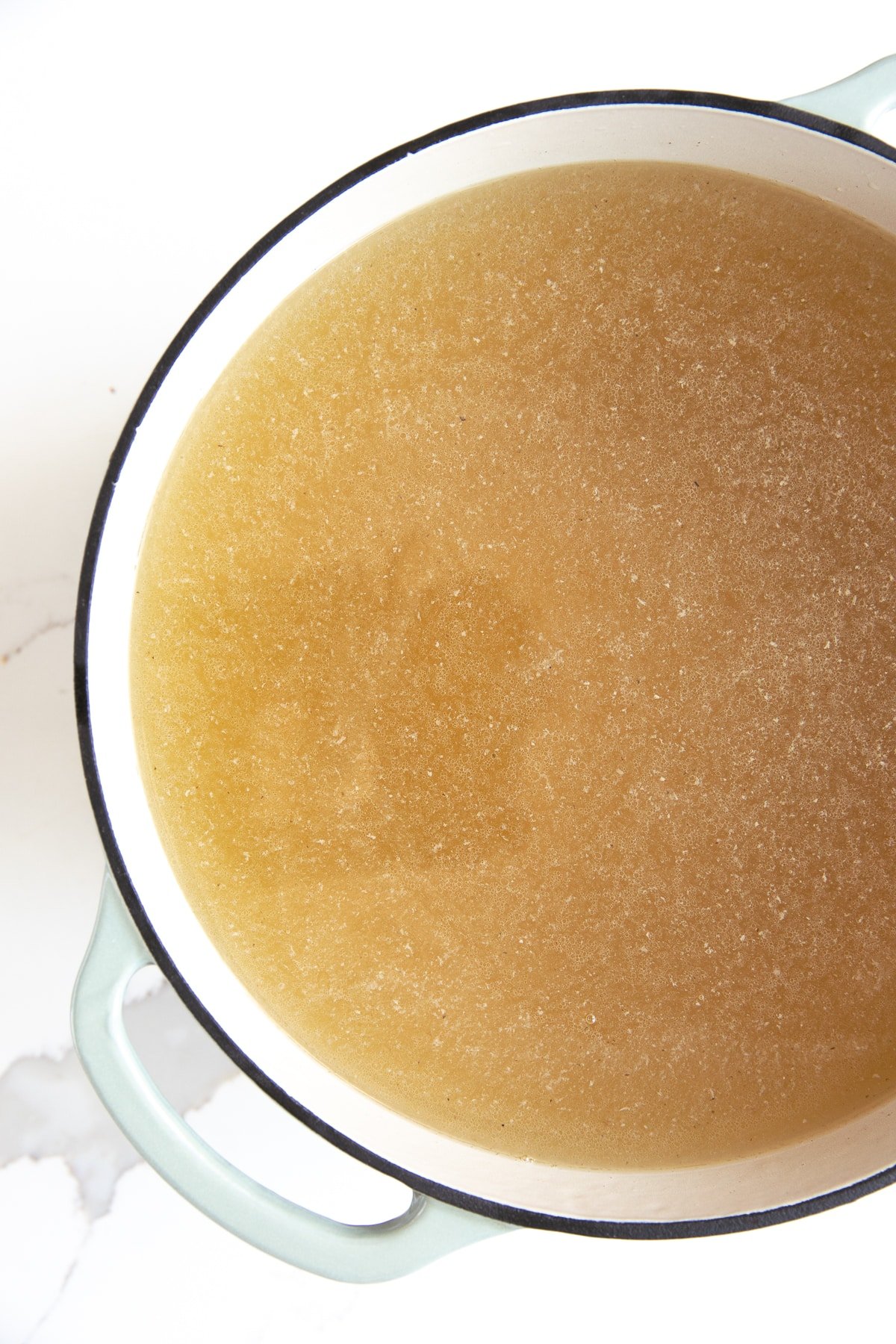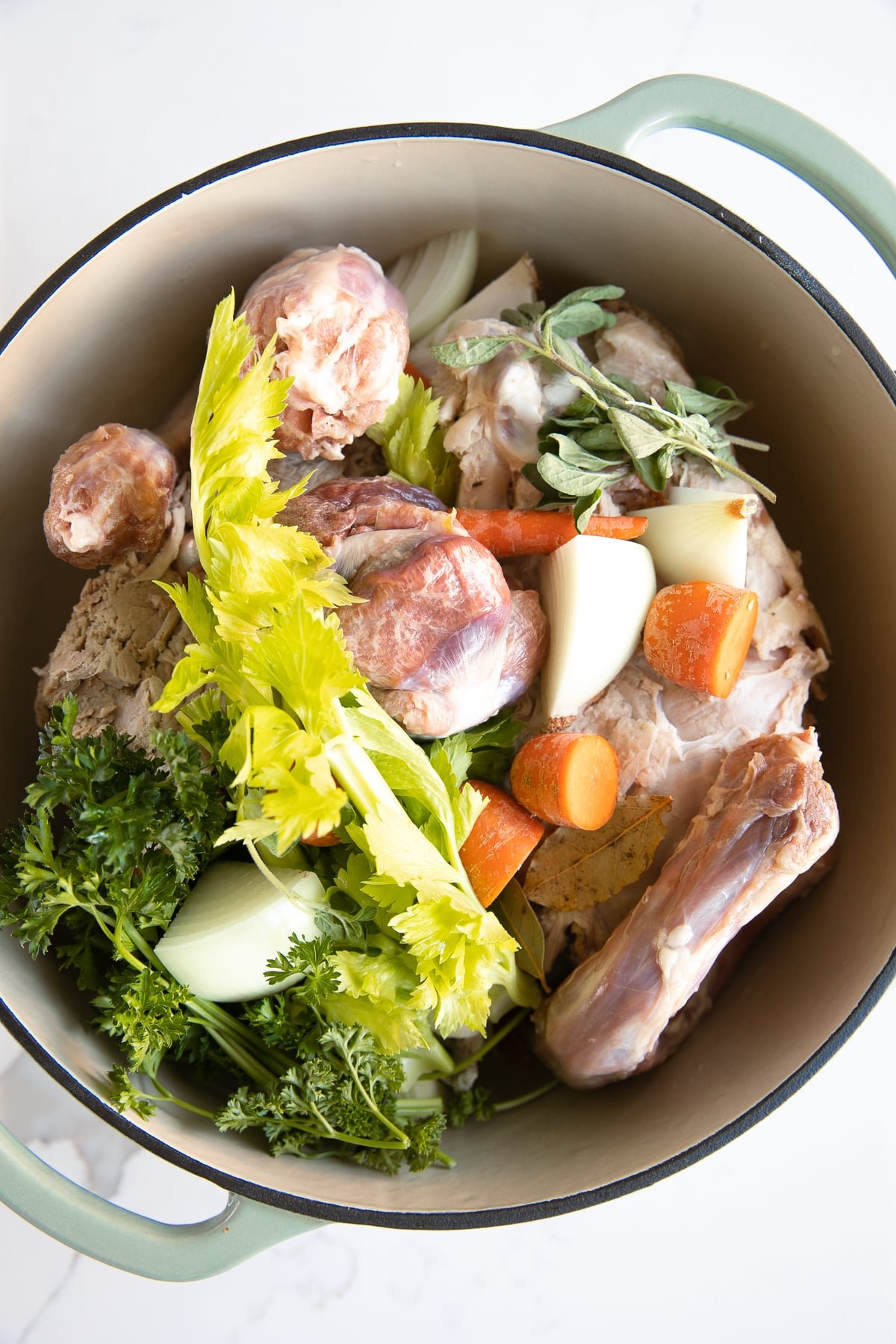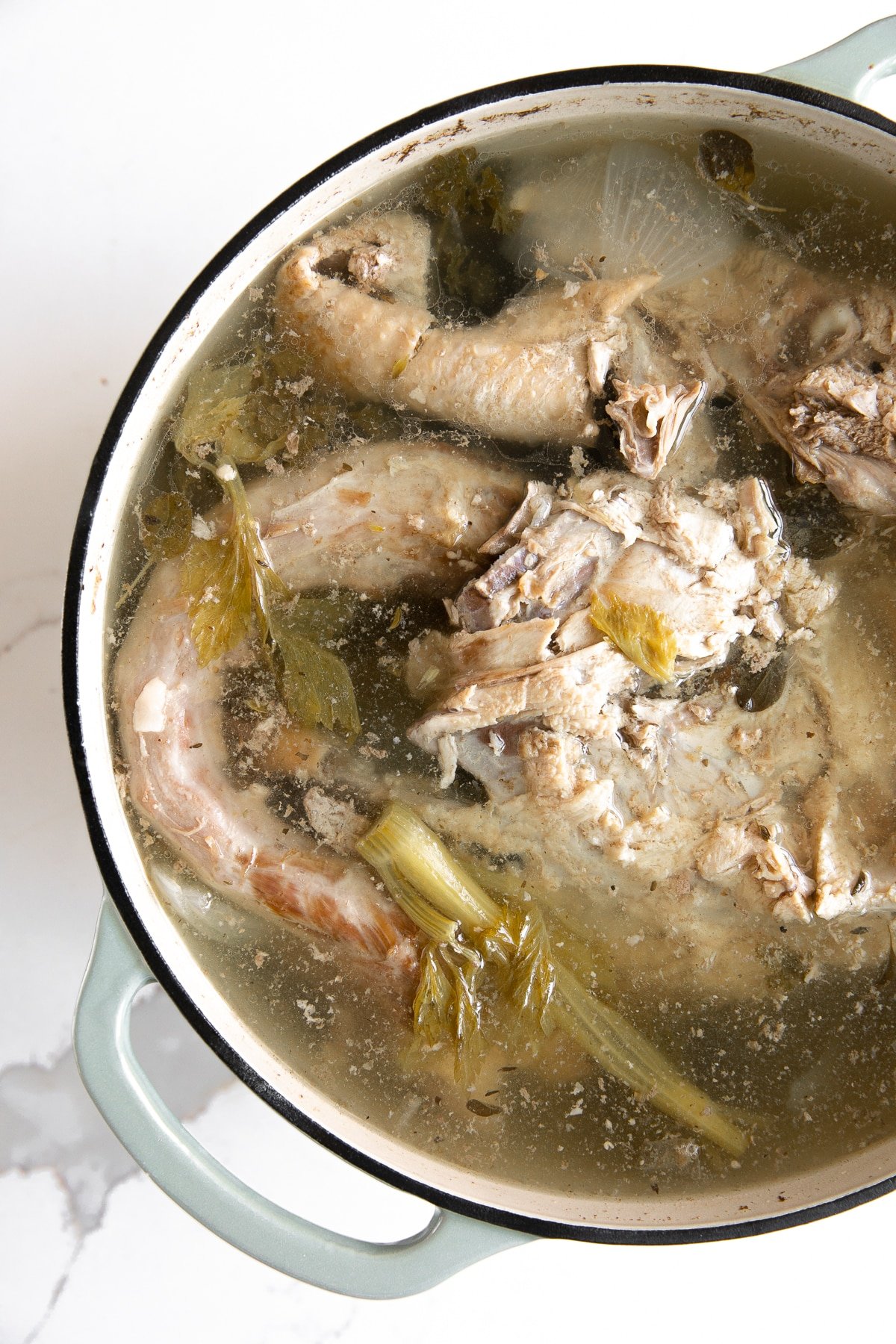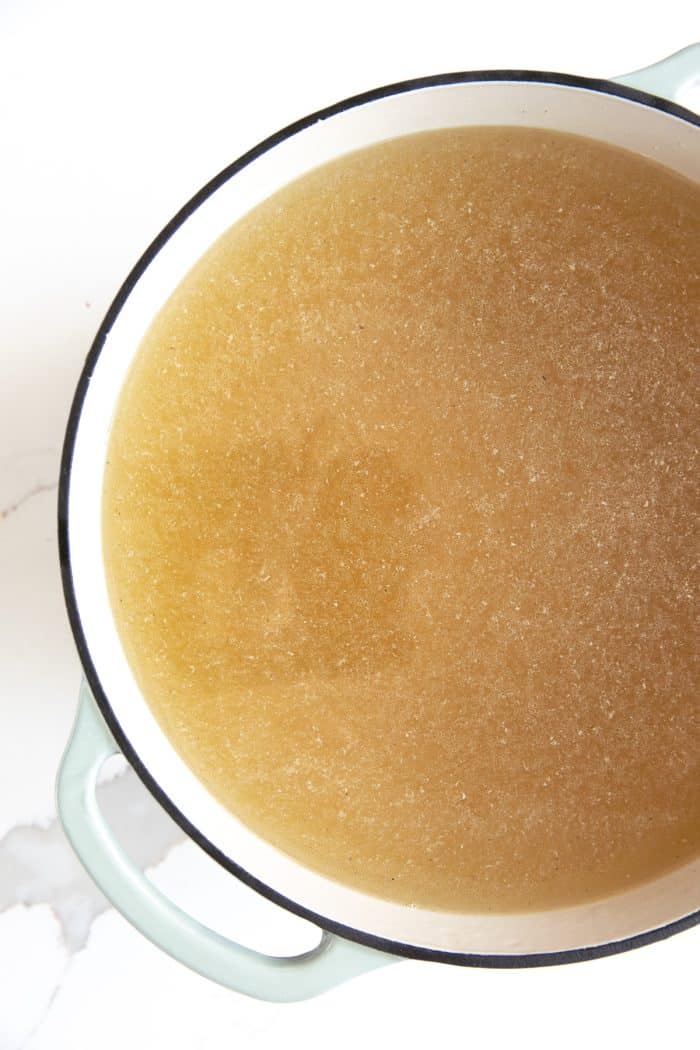This post may contain affiliate links. See my disclosure policy.
Learn How to Make Turkey Stock using the leftover bones, carcass, neck, and giblets from your Thanksgiving turkey. Use it to make nourishing soups and stews or freeze it for later.

Table of Contents
Turkey Stock Recipe
Thanksgiving turkeys are amazingly generous. They provide us with a delicious, day-of meal, extra meat to enjoy in all our favorite leftovers, and an entire picked apart carcass to make flavorful homemade stock.
The truth is that one of my favorite parts about cooking my Thanksgiving turkey recipe is knowing that I will get to use the leftover carcass to make homemade stock.
More flavorful than any stock or broth that you’ll get from the grocery store, making turkey stock is as easy as filling a pot with leftover turkey scraps, covering it with water, and simmering.
What will you do once your stock is made?
- Sip on it
- Use it to make flavorful homemade turkey soup
- Try it in risotto, paella, or congee
- Use it in any recipe that calls for homemade chicken stock or chicken broth
- Freeze it for later
Are you ready? Let’s learn how to make turkey stock!
What is the Best Turkey for Turkey Stock?
You will get the best flavor by using a leftover whole roasted turkey. Since most of us roast our turkeys for Thanksgiving dinner (or any other time we cook them), this should be a no-brainer.
For best results, plan ahead
- Purchase a turkey slightly larger than you expect you may need. Why? Well, I like to leave a little extra meat on the carcass whenever I make stock. It’s great for flavor.
- Save the neck bone and giblets and toss them in your pot when you make your stock.

How to Make Turkey Stock
1. Grab your largest stockpot or Dutch oven (at least 7.5 quarts) and add the leftover turkey carcass, any leftover turkey bones, turkey neck, and giblets (if you have them), veggies, fresh herbs, bay leaves, smashed garlic, and black peppercorns.
If you are using the carcass from an especially large turkey you may need to break it into 2-3 large pieces so that it can fit comfortably inside your pot.
How much salt should be added?
Hold off on adding any salt until the end of cooking as your turkey was (likely) already seasoned for roasting.
2. Cover the contents with cold water. Covering with cold water actually helps to extract more collagen from the bones.
3. Bring to a boil over high heat, then reduce to medium-low heat. Gently simmer for 3-4 hours.
4. Strain the stock, but first, use cooking tongs to carefully transfer the bones and carcass to a large bowl (discard). Next, pour the stock through a fine-mesh sieve into a clean pot or a large bowl. For a cleaner, clearer stock, line your fine-mesh strainer with a coffee filter or cheesecloth.

5. Let the stock cool before transferring to the refrigerator. Sometimes I will add a couple of handfuls of ice to my stock to help it cool faster.
6. You may store your stock in the refrigerator for up to one week, or freeze for up to 3-4 months (although I often leave mine frozen for much longer with no issues).
Can Turkey Stock Be Used to Replace Chicken Stock or Broth?
In many cases, yes! Depending on how well-seasoned your turkey was, you may end up with a stock that is more flavorful than chicken stock, and (most likely) chicken broth. That being said, turkey stock is just as delicious when used to cook rice and other grains, for soups and stews, and to make sauces and gravys! This Turkey Soup Recipe is a great place to get started.

Looking for more delicious stock and broth recipes? Try these reader favorites:
- Homemade Chicken Stock Recipe
- Bone Broth Recipe (How to Make Bone Broth)
- How to Make Instant Pot Bone Broth
Have you tried making this Turkey Stock Recipe?
Tell me about it in the comments below! I always love to hear your thoughts. And tag me #theforkedspoon on Instagram if you’ve made any of my recipes, I always love to see what you’re cooking in the kitchen.

Turkey Stock Recipe
Equipment
- Large stockpot
- Large bowl
- Tongs
- Fine-mesh strainer
Ingredients
- 1 cooked turkey carcass, with most of the meat removed and large bone segments broken into smaller pieces (see notes)
- 1 large onion, quartered
- 4 stalks celery, chopped into quarters
- 4 large carrots, chopped into quarters
- 3 garlic cloves, smashed
- 1 small bunch fresh parsley
- 2 bay leaves
- 8-10 whole black peppercorns
- about 4 quarts of water
- salt, to taste
Instructions
- Transfer your cooked turkey carcass to a large stockpot – I recommend something that can hold at least 7-8 quarts (for reference, the stockpot that you see in the images is a 7.5-quart capacity enameled Dutch oven). Add in the turkey neck, giblets, and leftover skin (if you have them).
- Add the onion, celery, carrots, garlic cloves, parsley, bay leaves, and black peppercorns (see notes).
- Cover the turkey and vegetables with about 4 quarts of cold water (or however much water is needed to fully submerge everything in your pot)
- Set your pot over high heat and bring to a rolling boil. Once it reaches a boil, reduce the temperature to medium-low to low heat and simmer for approximately 3-4 hours.
- Skim off any foam or "scum" settling on the top of your stock and add additional water to your pot should you notice the water level drop and expose the bones.
- To strain: Use cooking tongs to carefully transfer the bones and carcass to a large bowl. Set a fine-mesh strainer over a clean pot or a large bowl and pour the stock through the strainer into the pot (for a cleaner stock, line your fine-mesh strainer with a coffee filter or cheesecloth).
- Allow the stock to cool before transferring to air-tight jars or containers.
- Turkey stock can be kept in the refrigerator for up to 5-7 days, or in the freezer for approximately 3-4 months.
Notes
- If you have them, don’t forget to add the turkey neck and giblets. If you don’t have them, that’s ok, too.
- Feel free to add additional fresh herbs like rosemary, thyme, oregano, and basil. A couple of sprigs is all you’ll need.
- If you have any leftover pan drippings, toss those in as well (although it will make for a heavier, richer stock)
Nutrition
Nutrition information is automatically calculated, so should only be used as an approximation.

















Hello,
Do you roast your carcass before like you would to make beef broth?
Great question! I don’t roast the carcass again for this recipe, as the bones are already from a cooked, roasted turkey, so I just break them up, add the veggies and aromatics, and simmer.
If you are starting with a raw carcass, you can roast it first for a deeper, richer flavor. 🙂
Hi Jessica,
I’ve been using your turkey stock recipe for chicken (and occasionally turkey) stock for a couple of years now. It really does work for chicken stock splendidly too! Now that I know you have a chicken stock recipe I’ll try it next time. I freeze the stock in special soup storage/freezer containers that have 4 one cup sections. You can push out one section at a time so it is very convenient when recipes call for one or two cups of broth.
Thank you for sharing your cooking knowledge – you are appreciated!!
Thanks for the great feedback, Laura 🙂
I do have a separate post with additional information for chicken stock here that you can also check out.
Can you use this recipe to make chicken stock as well?
My Chicken Stock recipe would work better Bridget 🙂
I think you are terrific! I am wondering how you would divide the stock… since you mention using it for different dishes… would it be best to freeze it in quarts? Thanks!
Thanks, Kathy 🙂
I usually freeze it in different amounts – anywhere from a cup to a quart.
As it will just depend on how much you need for the particular recipe you are cooking with it.